#chandra x ray observatory
Text

A “Green Monster” Lurks in Star’s Debris
For the first time, astronomers have combined data from NASA’s Chandra X-ray Observatory and James Webb Space Telescope to study the well-known supernova remnant Cassiopeia A (Cas A). This work has helped explain an unusual structure in the debris from the destroyed star called the “Green Monster,” because of its resemblance to the wall in the left field of Fenway Park.
Image Credit: X-ray: NASA/CXC/SAO; Optical: NASA/ESA/STScl; IR: NASA/ESA/CSA/STScl/Milisavljevic et al., NASA/JPL/CalTech; Image Processing: NASA/CXC/SAO/J. Schmidt and K. Arcand
#art#cosmos#cosmic#universe#blast#space#photography#stars#monster#green#debris#chandra x ray observatory#james webb space telescope#supernova#cassiopeia#casA
64 notes
·
View notes
Text


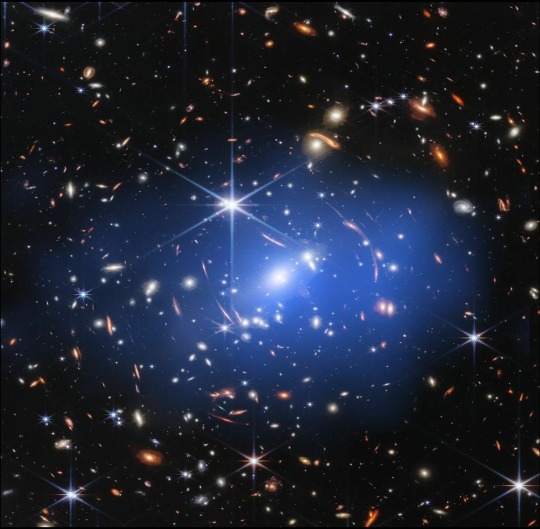
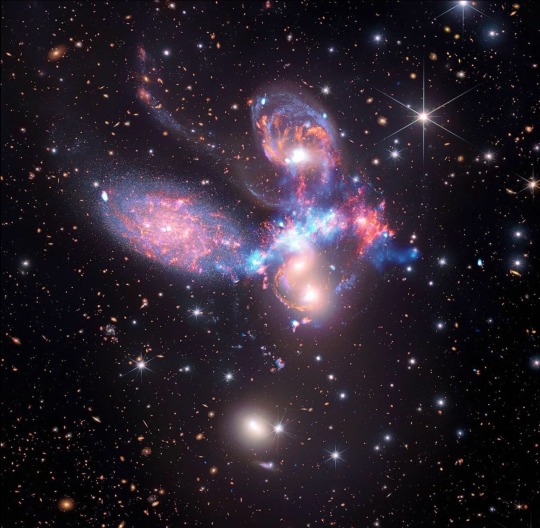
webb's infrared meets chandra's x-ray! technology is amazing <333
#nasa#jwst#james webb photos#james webb space technology#james webb update#james webb images#james webb telescope#chandra x ray observatory#space#outer space#galaxy#stars#sky#astronomy#stephan's quintet#cartwheel galaxy#deep field#carina nebula#aesthetic
958 notes
·
View notes
Text


Stephan's Quintet + Cartwheel Galaxy 🪐⊹ ࣪˖* ·
145 notes
·
View notes
Text
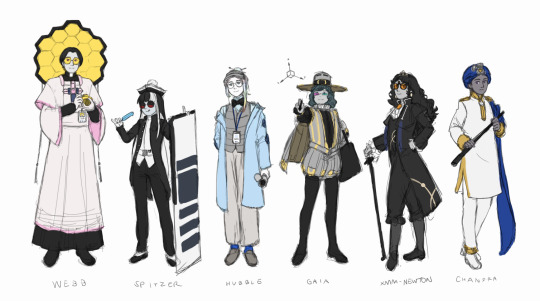
Telescopes 👀😶
#space#character design#gijinka#personification#nasa#esa#space telescope#oh boy time to tag everybody hang tight#jwst#james webb space telescope#spitzer space telescope#hubble#esa gaia#xmm-newton#chandra x ray observatory#religious imagery#priests#christian imagery#thanks webb#artists on tumblr
207 notes
·
View notes
Text

In 2009, NASA overlaid matching images from Hubble, Spitzer, and the Chandra X-ray Observatory to produce this incredible image highlighting each of the telescopes' different wavelength views of the center of our Milky Way galaxy.
"In this spectacular image, observations using infrared light and X-ray light see through the obscuring dust and reveal the intense activity near the galactic core. Note that the center of the galaxy is located within the bright white region to the right of and just below the middle of the image. The entire image width covers about one-half a degree, about the same angular width as the full moon." - NASA
(©)
#go for queue deploy#nasa#nasa hubble telescope#hubble#spitzer#nasa spitzer#nasa chandra#chandra x ray observatory#astronomy#astrophotography#galaxy#nebula#stars#cosmos#cosmic
377 notes
·
View notes
Text
My brain hurts, but-
THE MOST POWERFULL ERUPTION FROM A BLACK HOLE EVER HAS BEEN SEEN!!!

This is SDSS J1531, a massive supercluster of galaxies.
In the centre, approximately 3.8 billion light-years away, two of the biggest galaxies of the clusters are colliding, which ALSO means their supermassive black holes will merge & they have a lot of material to feed on, which leads to many radiation bursts.
The images made by ChandraX, LOFAR & Hubble show the close-in view of the centre of the two colliding galaxies.
The "beads"
It is theorized that the black hole eruption is responsible for the creation of 19 star clusters because it pushed the hot gas away from the black hole, creating a cavity, which can be seen in the zoomed in picture with the blue dots (X-Ray), that look like wings.
It's thought that tidal effects from the two merging galaxies compressed the gas alongside these "wings," leading to this "beads on a string"-pattern.
I know it has been a while since my last infodump & I am truly sorry. It's kind ot hard to exist but I'll bravely continue to do so.
#donatello infodumps#donnies exceptional mind#turtle net#rottmnt#space is awesome#donnies special interests#astrophysics is the best#i love to infodump#nasa#chandra x ray observatory#black holes#black holes are so cool#autistic infodumping#queued post
15 notes
·
View notes
Text
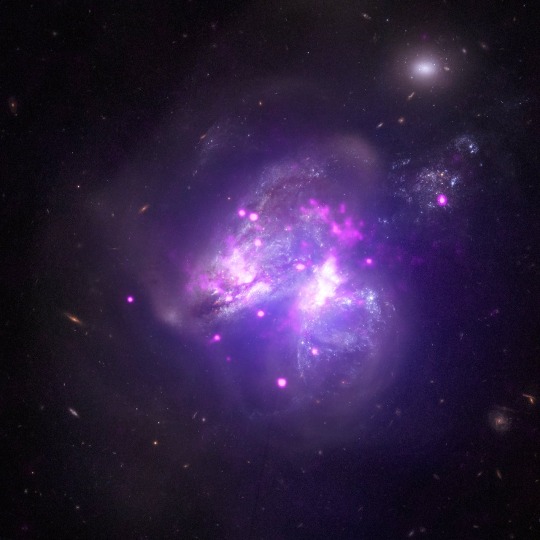
💫 “Today Chandra is studying a Black Hole in Ursa Major. Nearby in the sky two galaxies are merging in Arp 299. At least 14 "ultra-luminous X-ray sources" (ULXs) have been discovered here. All are likely black holes or neutron stars pulling material from a companion star.”
source . more from chandra x-ray observatory .
#space#chandra#chandra observatory#chandra x ray observatory#nasa#outer space#black hole#Ursa Major#constellations#neutron stars#stars#neutron star#galaxy#galaxies#space photography#astronomy
93 notes
·
View notes
Text

Someone's excited about Christmas (And their birthday)
#I drew this back on the first of December and man I should have posted it back then too#But yeah Webb is the type of guy to start blasting Mariah Carey as soon as it becomes December#Also having so much fun with my fineliner#traditional art#fanart#oc artwork#spacecraft#gijinka#gijinka art#personification#jwst#chandra x ray observatory#Ps while I do have a Chandra character I don't have a design for them yet. I have been stuck on it for weeks 😔#james webb space telescope
36 notes
·
View notes
Text
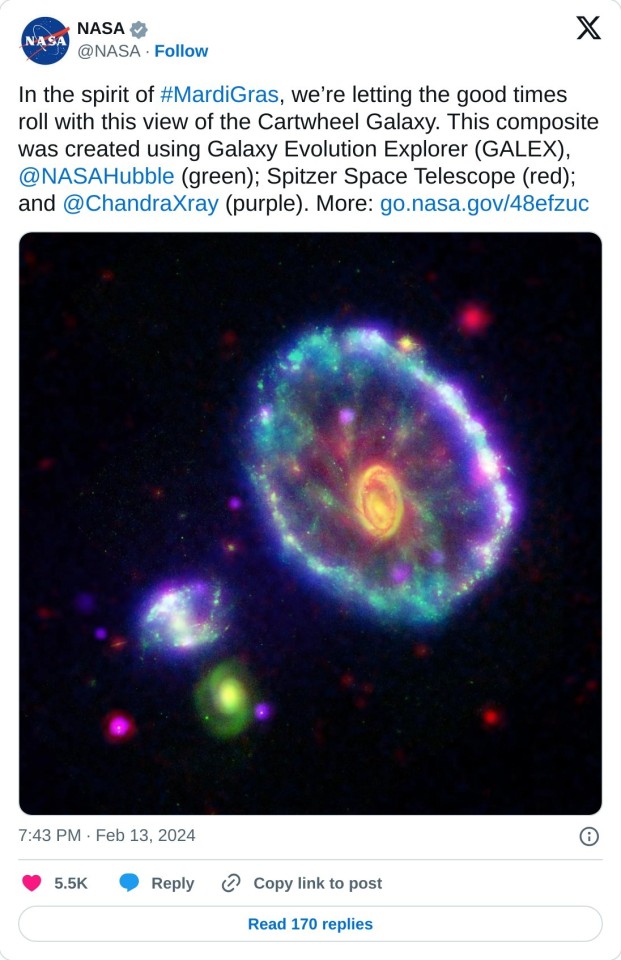
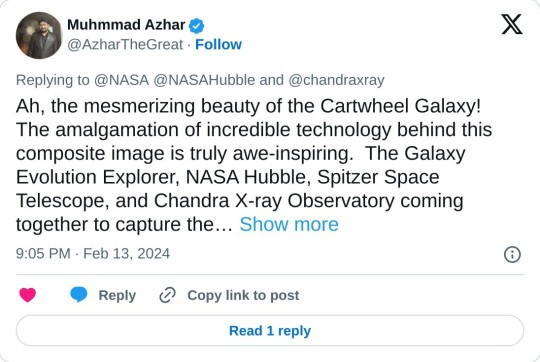
cosmic dance of colors. Its a splendid tribute to the power of human curiosity and the wonders of the cosmos. Thanks for sharing this celestial marvel!
#this is my favorite#MardiGras#Cartwheel Galaxy#galaxy#Spitzer Space Telescope#galaxies#hubble space telescope#chandra x ray observatory#beautiful nature#amazing nature#astronomy#Nasa
3 notes
·
View notes
Text


Barbie | Oppenheimer
14 notes
·
View notes
Text



Friday, February 23, 2024
I made patterns for our light box based on images from the Chandra X-Ray Observatory today.
2 notes
·
View notes
Text
NGC 1850, a start cluster about 160, 000 light years away in satellite galaxy to our own milky way, known as the Large Magellanic cloud.

#astrology observations#astrophotography#astroworld#astronaut in the ocean#Starry sights#hubbleimage#nasa jpl#chandra x ray observatory#galaxy#content: universe#tumblr people#aestethic
22 notes
·
View notes
Photo

NGC 253: Chandra determines what makes a galaxy's wind blow On Earth, wind can transport particles of dust and debris across the planet, with sand from the Sahara ending up in the Caribbean or volcanic ash from Iceland being deposited in Greenland. Wind can also have a big impact on the ecology and environment of a galaxy, just like on Earth, but on much larger and more dramatic scales. A new study using NASA's Chandra X-ray Observatory shows the effects of powerful winds launched from the center of a nearby galaxy, NGC 253, located 11.4 million light-years from Earth. This galactic wind is composed of gas with temperatures of millions of degrees that glows in X-rays. An amount of hot gas equivalent to about two million Earth masses blows away from the galaxy's center every year. NGC 253 is a spiral galaxy, making it similar to our Milky Way. However, stars are forming in NGC 253 about two to three times more quickly than in our home galaxy. Some of these young stars are massive and generate a wind by ferociously blowing gas from their surfaces. Even more powerful winds are unleashed when, later in their relatively short lives, these stars explode as supernovae, and hurl waves of material out into space. NGC 253 gives astronomers a keyhole through which to study this important phase in the stellar life cycle. The material that the young stars send out into intergalactic space across hundreds of light-years is enriched with elements forged in their interior. These elements, which include many responsible for life on Earth, are folded into the next generations of stars and planets. A new composite image of NGC 253 in the inset includes Chandra data (pink and white) showing that these winds blow in two opposite directions away from the center of the galaxy, to the upper right and lower left. Also shown in this image is visible light data (cyan) and emission from hydrogen (orange), both from a 0.9 meter telescope at Kitt Peak Observatory, and infrared data from NASA's Spitzer Space Telescope (red). From Earth's vantage point, NGC 253 appears nearly edge-on, as seen in the wider image in the graphic, which shows an optical image from the European Southern Observatory's La Silla Observatory in Chile. A team led by Sebastian Lopez of The Ohio State University in Columbus, Ohio, used deep Chandra observations, taken over four days, to study the properties of the wind. They found that the densities and temperatures of the gas in the wind are the highest in regions less than about 800 light-years from the center of the galaxy—and then decrease with distance farther away. These results disagree with an early model where the winds from so-called starburst galaxies like NGC 253 are spherical. Instead, recent theoretical work predicts that a more focused wind should be formed by a ring of "super star clusters" located near the center of NGC 253. Super star clusters contain large numbers of young, massive stars. The focused nature of the wind observed by Lopez and his team therefore supports the idea that the super star clusters are a major source of the wind. However, there is not complete agreement between theory and observations, suggesting there is physics missing from the theory. A hint about what is missing comes from the team's observation that the wind cools rapidly as it moves away from the center of the galaxy. This suggests that the wind is plowing up cooler gas, causing the wind to cool and slow down. Such a 'wind plow' effect might be the extra physics required to produce better agreement between theory and observations. Lopez and his colleagues also studied the composition of the wind, including how elements like oxygen, neon, magnesium, silicon, sulfur, and iron are scattered across the structure. They found that these elements become much more diluted farther away from the center of the galaxy. Astronomers did not see such a rapid decrease in the amounts of these elements in the wind from another well-studied galaxy undergoing a burst of star formation, M82. Astronomers will need future observations of other galaxies with winds to understand whether this difference is related to the general properties of the galaxies, such as the total mass of the stars they contain. A paper describing these results was published in The Astrophysical Journal. IMAGE.....This release features an optical image of the spiral galaxy NGC 253, and a separate composite closeup of the galaxy's bright center. In both images, the galaxy is set against the blackness of space, which is dotted with specks of light. From a distance, spiral galaxies appear round and flat, like disks. Here, NGC 253's flat edge is shown, not its round face. In the primary image, the galaxy resembles the edge of a dinner plate made of gold and silver clouds, tilted diagonally from our upper left to our lower right. The galaxy appears bright and dense near the center, and thinner near the veiny outer rim. Tiny specks of neon pink appear throughout the golden core and silver edges. A closeup of the galaxy's center is presented in a separate, composite image. In this composite rendering, the heart of the galaxy is shown in a variety of colors. At the center is a misty, neon pink blob with a brilliant white core. This is a galactic wind of extremely hot gas, detected by Chandra's X-ray Observatory. Surrounding the misty neon pink blob is a cyan, or greenish-blue, swirl, and mottled burnt orange and red clouds. The swirling cyan represents visible light data and the burnt orange represents hydrogen emissions, both from the Kitt Peak National Observatory. The red represents infrared data from NASA's Spitzer Space Telescope. This composite closeup shows hot winds blowing in opposite directions away from the center of the galaxy. These powerful winds are spreading stellar material to the galaxy's next generation of stars and planets. Credit: Chandra X-ray Center
18 notes
·
View notes
Text
Supernova Remnant G1.9+0.3

image by NASA's Chandra X-Ray Observatory et al
25,000 light-years away in the constellation Sagittarius, a star went supernova, violently exploding to create remnant G1.9+0.3
although the star died long ago, its light reached Earth just about 110 years ago, making it the youngest known supernova remnant in the Milky Way Galaxy
G1.9+0.3's cast-off outer shells contain the most energetic electrons ever observed in a supernova remnant, and they're expanding outward at an unprecedented 35 million miles (56 million kilometers) per hour - about 5% the speed of light
8 notes
·
View notes
Text



Concept and exploration sketches of NASA's Great Observatories (Hubble, Chandra, Spitzer, Compton)
#space#oc art#sketchdump#doodles#astronomy#spacecraft#hubble space telescope#chandra x ray observatory#spitzer#spitzer space telescope#compton gamma ray observatory#gijinka#personification#I'll get to compton later I'm sorry#also Spitzer was heavily based on Papa Emeritus III of Ghost#because I guessed it would fit with the black white colour palette
63 notes
·
View notes
Text
IXPE Measures Exploded Star Remains
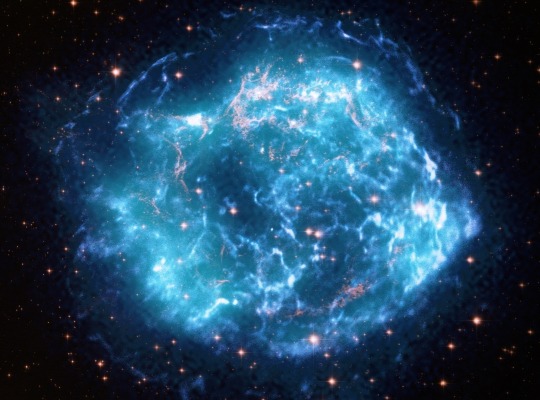
When a massive star collapsed in the Cassiopeia constellation, it generated a supernova explosion with some of the fastest shockwaves in the Milky Way. These speedy shock waves are one of the reasons the Cassiopeia A (Cas A) supernova remnant was chosen to be our Imaging X-ray Polarimetry Explorer's (IXPE) first observed object.
This composite image, made of data from IXPE, the Chandra Observatory, and the Hubble Telescope, shows Cas A. IXPE's investigation of Cas A from Jan. 11 to Jan. 29, 2022, added crucial information about the behavior of exploded stars' magnetic fields: scientists found that the magnetic fields in X-rays tend to be aligned in radial, not perpendicular, directions. Polarization data also suggest that these X-rays come from turbulent regions with many different magnetic field directions.
Image Credits: X-ray: Chandra: NASA/CXC/SAO, IXPE: NASA/MSFC/J. Vink et al.; Optical: NASA/STScI
#2022#your friendly neighborhood space nerd#nasa#space#constellation#cassiopeia#supernova#milky way#Cas A#chandra x ray observatory#astronomy
9 notes
·
View notes